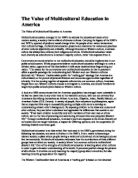Exploration of the Divergent Cultural Relationships with Land in Leslie Marmon Silko's Ceremony
Rabago
Raquel Rabago
Professor Combiths
English 1106
20 September 2004
Exploration of the Divergent Cultural Relationships with Land in
Leslie Marmon Silko’s Ceremony
In her novel, Ceremony, Leslie Marmon Silko uncovers the innumerable contrasts of the white ranchers and the Native Americans. The natives feel helpless as the whites spill themselves upon the contiguous hillsides and valleys. The commanding whites steal the land which had never before belonged to any single entity. Unable to retain their land, the Native Americans can only continue their existence on the allotted land, and attempt to cleave unto their heritage that is contained in the very soil beneath the mountains. The analysis of the white and Native American communities’ respect for, effects on, and interactions with the land allows for the exploration of their cultural relationships with the land.
The varying degrees of respect the white inhabitants and Native Americans have for their surroundings can be examined as one of many factors of their relationships with the land. The whites have minimal respect for the land; they manipulate it, tame it, in pursuit of nothing more than monetary gain. The main character of the novel, Tayo, explores his feelings about the whites, “The destroyers had sent them to ruin this world, and day by day they were doing it” (204). The whites are eating away at the valuable resources of the land and casting the fruits of nature away, unworthy and untouched. The Native Americans conclude the whites to be the dreadful creatures their ancestors feared and dreaded, the creatures which would lead to the world’s inevitable destruction and downfall. The whites begin hoarding the land, taking what could never belong to them, the trespassers, the intruders. They harbor no connection with the land that provides for them, nor are they aware of what may become of the land if it is treated harshly. The whites’ eyes are focused upon sales and property lines. The sentiments of the Native Americans as the whites creep into their cherished homeland is illustrated by the following passage, “And it was then that the Laguna people understood that the land had been taken, because they couldn’t stop these white people from coming to destroy the animals and the land” (186). The Natives are powerless and incapable of preventing the destruction of the land they embrace so intimately. They are helpless as a more powerful race demeans their land with barbed fences and heartless hunters scourging the countryside, “like the hunting of a mountain lion, was their idea of sport and fun” (213). The whites give no thanks or prayer to the mother earth when she releases the life of a creature to them; they are seemingly unfeeling and inhuman. On page 135, Silko utilizes a fabricated Native American tale seemingly spun during the dawn of time to illustrate what the white people of the future would be like. “They see no life/ When they look/ they only see objects. / The world is a dead thing to them/ the trees and rivers are not alive. /They see no life.” They neither feel the breath of the wind at their shoulders, nor hear the laugh of the babbling springs; the whites are spiritually dead because the land, as they see it, has never been alive. In drastic comparison, The Native Americans cherish and respect the land in myriad ways. Josiah shares with Tayo the understanding that the land is their mother, “there are some things worth more than money…this is where we come from […] the earth keeps us going” (45). The land that the Native Americans occupy is not solely the place of their residence. The earth is invaluable to them; it breathes life into each moment of every day. Money is of little comparison to the intrinsic value of the Native Americans birthplace, home, and cornerstone. More crucial to them is the protection of the land from harm, praising the land for its generous offerings, and the respect for all things living. “He stepped carefully, pushing the toe of his boot into the weeds first to make sure the grasshoppers were gone before he set his foot down” (155). Tayo ensures that no insects will be harmed by his presence; the Native Americans appreciate the sacred nature of living organisms. Along with other Native Americans, Tayo feels connected to even the smallest animals in the sense that they share the same mother, the land they proudly call their home. The medicine man, Betonie, comments on the view from his home in the mountains, “my grandmother would not leave this hill. She said the world could be seen from here” (131). The Native Americans appreciate the vast stretch of the horizon and are passionate even concerning things that are unseen and remote. Even the silent snow capped mountains are precious faces of time in their hearts, “the sacred mountain was a dusty, dry blue color” (100) [emphasis added]. The Native Americans very sense of belonging, identity, and being is founded upon the land they revere, “The ear for the story and the eye for the pattern was theirs; the feeling was theirs: we came out of this land and we are hers” (255). While the whites are preoccupied with taking things of value from the land, the Native Americans’ only concern is for the preservation of their source of being and power, their mother, their hope.







